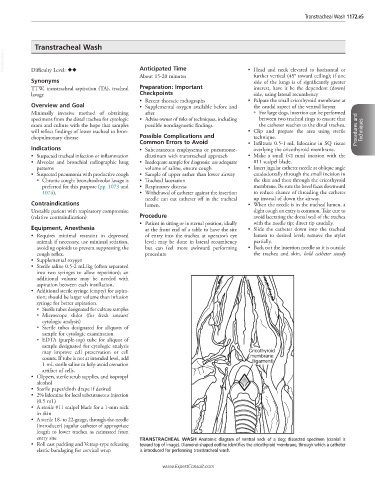Page 2373 - Cote clinical veterinary advisor dogs and cats 4th
P. 2373
Transtracheal Wash 1172.e5
Transtracheal Wash
VetBooks.ir Anticipated Time
Difficulty Level: ♦♦
further vertical (45° toward ceiling); if one
About 15-20 minutes • Head and neck elevated to horizontal or
Synonyms side of the lungs is of significantly greater
TTW, transtracheal aspiration (TA), tracheal Preparation: Important interest, have it be the dependent (down)
lavage Checkpoints side, using lateral recumbency
• Recent thoracic radiographs • Palpate the small cricothyroid membrane at
Overview and Goal • Supplemental oxygen available before and the caudal aspect of the ventral larynx
Minimally invasive method of obtaining after ○ For large dogs, insertion can be performed
specimens from the distal trachea for cytologic • Advise owner of risks of techniques, including between two tracheal rings to ensure that
exam and culture with the hope that samples possible nondiagnostic findings. the catheter reaches to the distal trachea.
will reflect findings of lower tracheal to bron- • Clip and prepare the area using sterile Procedures and Techniques
chopulmonary disease Possible Complications and technique.
Common Errors to Avoid • Infiltrate 0.5-1 mL lidocaine in SQ tissue
Indications • Subcutaneous emphysema or pneumome- overlying the cricothyroid membrane.
• Suspected tracheal infection or inflammation diastinum with transtracheal approach • Make a small (<1 mm) incision with the
• Alveolar and bronchial radiographic lung • Inadequate sample for diagnosis: use adequate #11 scalpel blade.
patterns volume of saline, ensure cough • Insert jugular catheter needle at oblique angle
• Suspected pneumonia with productive cough • Sample of upper rather than lower airway caudodorsally through the small incision in
○ Chronic cough: bronchoalveolar lavage is • Tracheal laceration the skin and then through the cricothyroid
preferred for this purpose (pp. 1073 and • Respiratory distress membrane. Be sure the bevel faces downward
1074). • Withdrawal of catheter against the insertion to reduce chance of threading the catheter
needle can cut catheter off in the tracheal up instead of down the airway.
Contraindications lumen. • When the needle is in the tracheal lumen, a
Unstable patient with respiratory compromise slight cough on entry is common. Take care to
(relative contraindication) Procedure avoid lacerating the dorsal wall of the trachea
• Patient in sitting or in sternal position, ideally with the needle tip; direct tip caudally.
Equipment, Anesthesia at the front end of a table to have the site • Slide the catheter down into the tracheal
• Requires minimal restraint in depressed of entry into the trachea at operator’s eye lumen to desired level; remove the stylet
animal; if necessary, use minimal sedation, level; may be done in lateral recumbency partially.
avoiding opioids to prevent suppressing the but can feel more awkward performing • Back out the insertion needle so it is outside
cough reflex. procedure the trachea and skin, hold catheter steady
• Supplemental oxygen
• Sterile saline 0.5-2 mL/kg (often separated
into two syringes to allow repetition); an
additional volume may be needed with
aspiration between each instillation,
• Additional sterile syringe (empty) for aspira-
tion; should be larger volume than infusion
syringe for better aspiration.
○ Sterile tubes designated for culture samples
○ Microscope slides (for fresh smears/
cytologic analysis)
○ Sterile tubes designated for aliquots of
sample for cytologic examination
○ EDTA (purple-top) tube for aliquot of
sample designated for cytologic analysis
may improve cell preservation or cell Cricothyroid
d
counts. If tube is not at intended level, add membrane
(ligament)
1 mL sterile saline to help avoid crenation
artifact of cells.
• Clippers, sterile scrub supplies, and isopropyl
alcohol
• Sterile paper/cloth drape if desired
• 2% lidocaine for local subcutaneous injection
(0.5 mL)
• A sterile #11 scalpel blade for a 1-mm nick
in skin
• A sterile 18- to 22-gauge, through-the-needle
(introducer) jugular catheter of appropriate
length to lower trachea as estimated from
entry site TRANSTRACHEAL WASH Anatomic diagram of ventral neck of a dog; dissected specimen (cranial is
• Roll cast padding and Vetrap-type releasing toward top of image). Diamond-shaped outline identifies the cricothyroid membrane, through which a catheter
elastic bandaging for cervical wrap is introduced for performing transtracheal wash.
www.ExpertConsult.com

